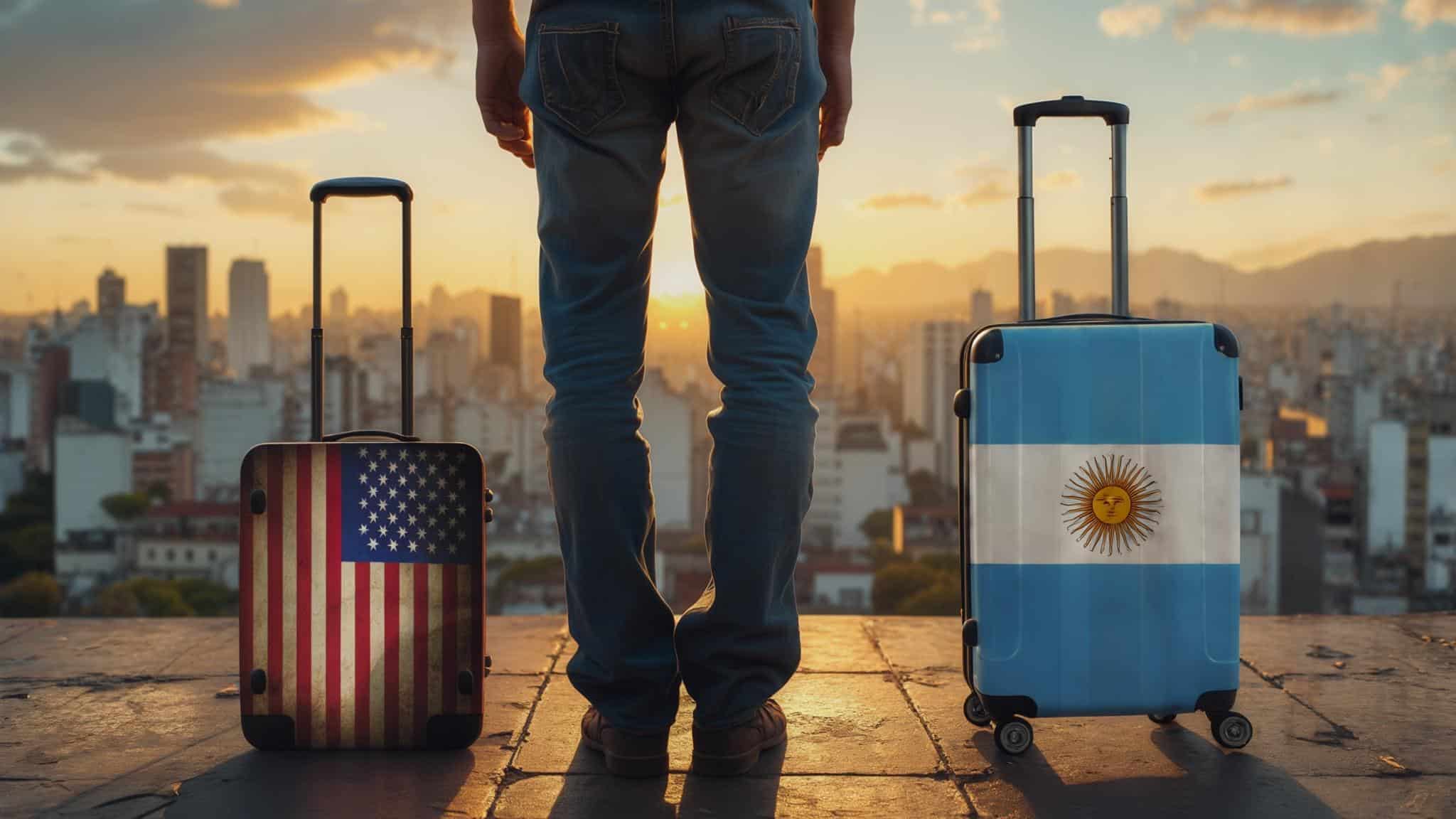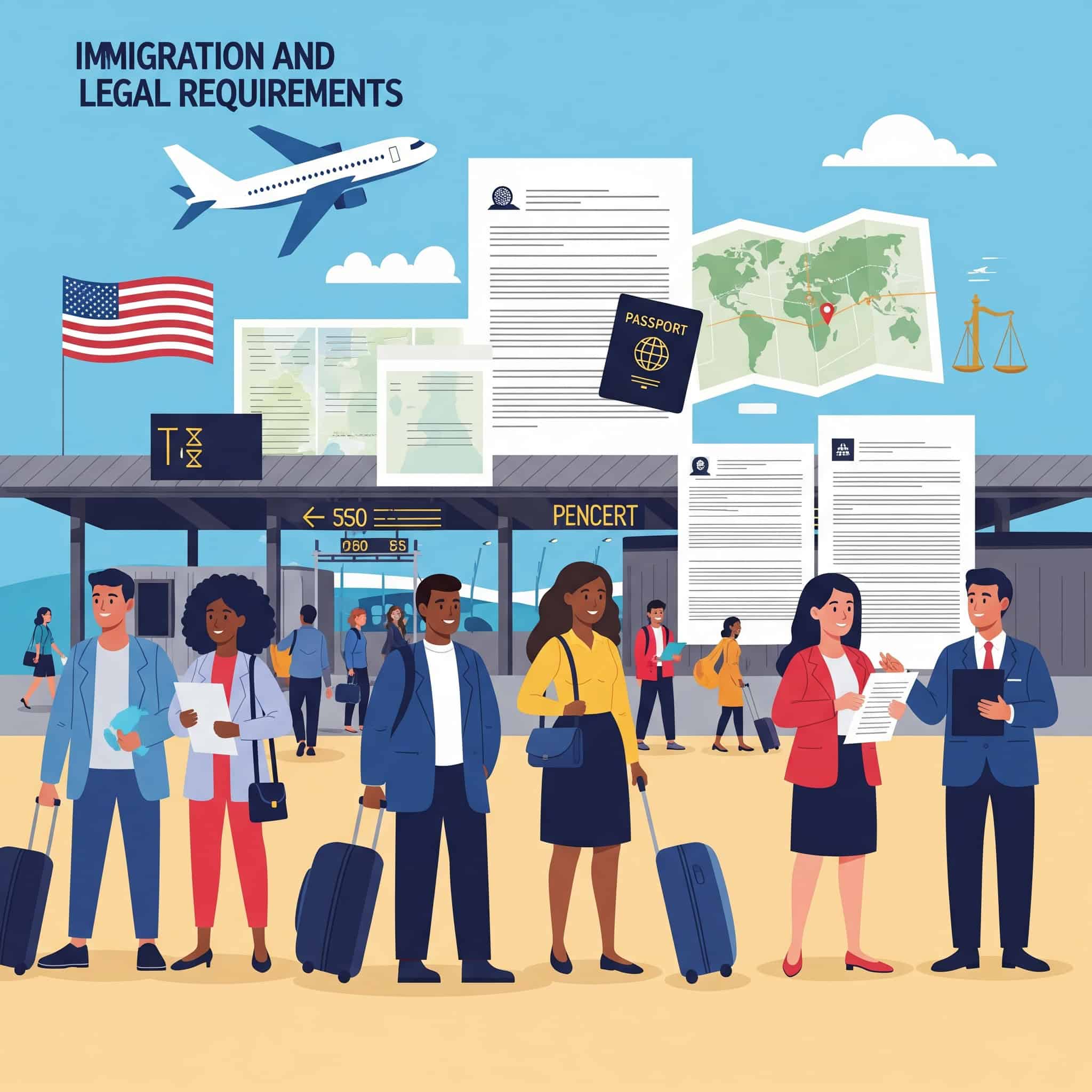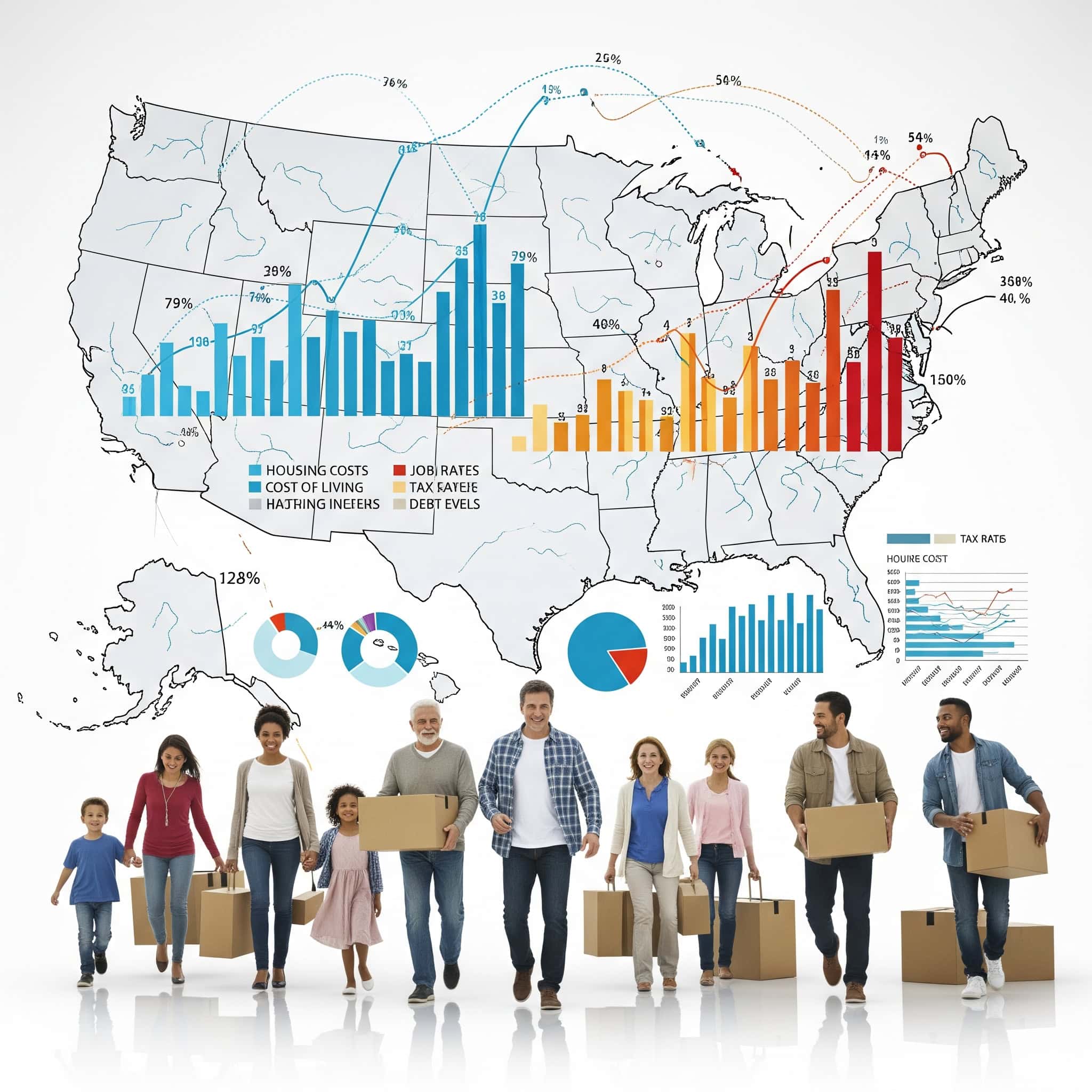Moving to Argentina from the US: 25 Essential Aspects You Need to Know
According to recent data from the US State Department, over 40,000 Americans currently live in Argentina, with numbers increasing by approximately 15% annually since 2020. I discovered this trend while researching my own potential move to Argentina last year. The combination of lower cost of living, vibrant culture, and flexible visa options makes Argentina increasingly attractive for Americans seeking international relocation. However, moving to a new country involves numerous considerations beyond just packing your bags. This comprehensive guide breaks down the 25 most important aspects you need to understand before moving to Argentina from US.
Table of Contents
Immigration and Legal Requirements
Financial and Economic Factors
Lifestyle and Cultural Adaptation
Practical Logistics
Long-term Planning
How Jiffy Junk Can Help
Final Thoughts
Immigration and Legal Requirements
1. Visa Options for US Citizens
Argentina offers several visa pathways for Americans looking to relocate. The most common options include temporary residency visas (valid for 1-2 years), permanent residency visas (available after maintaining temporary status), and specific categories like the Rentista visa for those with passive income or the newer Digital Nomad visa launched in 2022. Each visa type has distinct requirements, processing timeframes, and limitations you must understand before application.
The Rentista visa requires documented proof of at least $2,000 USD monthly passive income, while the Digital Nomad visa allows remote workers to stay initially for 180 days with possible extensions.
Processing times typically range from 2-6 months, with requirements changing frequently, making professional immigration assistance highly recommended for navigating the bureaucratic process.
Visa Type | Duration | Primary Requirements | Best For |
|---|---|---|---|
Tourist Visa | 90 days | US passport | Short visits, exploratory trips |
Digital Nomad | 180 days (extendable) | Remote employment, min. $2,000/month income | Remote workers |
Rentista | 1-2 years | Passive income of $2,000+/month | Retirees, investors |
Temporary Residency | 1-2 years | Varies by category | Path to permanent status |
Permanent Residency | Indefinite | Prior temporary residency | Long-term settlers |
I’ve found that many Americans underestimate the complexity of the visa process when planning to immigrate to Argentina. What looks straightforward on government websites often involves numerous additional steps and documentation requirements that only become apparent once you’re in the system.
2. Residency Process Steps
Obtaining Argentine residency follows a structured path that begins with temporary status before progressing to permanent residency. The process requires specific documentation that must be properly authenticated. You’ll need to prepare these documents months in advance, as the collection and authentication process can be time-consuming. Most Americans spend 2-3 years on temporary status before becoming eligible for permanent residency.
Required documentation includes an FBI background check with apostille, birth certificate with apostille, proof of income, passport photos, and completed application forms in Spanish.
Document preparation typically takes 1-3 months before you can even submit your application, making advance planning crucial for a smooth transition to immigration to Argentina.
3. Document Authentication Requirements
US documents aren’t automatically recognized in Argentina—they require apostille certification to be considered valid. This authentication process applies to essential documents like birth certificates, marriage certificates, divorce decrees, and criminal background checks. The apostille verifies the document’s legitimacy for Argentine authorities and is a non-negotiable step in your immigration process. Before you begin the authentication process, consider decluttering your home office to better organize your important documents. Our comprehensive decluttering guide can help streamline this critical preparation step.
Each document must be apostilled by the Secretary of State in the US state where it was issued, creating a multi-step process for documents from different states.
The authentication process typically takes 2-4 weeks per document and may require professional assistance, especially for expedited processing.
John, a software engineer from Boston, learned the hard way about document authentication when he arrived in Buenos Aires with his original birth certificate but without the apostille. Despite having all other paperwork in order, his residency application was rejected. He had to ship his birth certificate back to Massachusetts for apostille certification, which took an additional 6 weeks and delayed his entire immigration process. He now advises other expats to start the document authentication process at least 3 months before their planned move date.
4. Tax Obligations Between Countries
Moving to Argentina doesn’t eliminate your US tax obligations. As a US citizen, you remain subject to US taxation on worldwide income regardless of where you live. Additionally, after establishing residency in Argentina (typically after 12 months), you’ll become subject to Argentine taxation on your global income as well. Understanding how to navigate these dual tax requirements is essential for financial planning and compliance.
While the US-Argentina tax treaty helps prevent double taxation, you’ll still need to file returns in both countries and may need to pay taxes in both jurisdictions depending on income sources.
Tax planning before your move can prevent costly mistakes, with strategies like the Foreign Earned Income Exclusion potentially saving US citizens thousands in tax liability.
I’ve spoken with many Americans living in Argentina who initially overlooked the complexity of managing their tax obligations across two countries. The reality is that proper tax planning should begin months before your physical relocation to avoid complications that could affect your financial stability.
5. Banking Regulations and Restrictions
Argentina’s banking system differs significantly from the US system, with more restrictions and regulations affecting foreign account holders. Opening a local bank account requires a tax ID (CUIT) and proof of residency, which you can only obtain after arriving in the country. Many expats in Argentina maintain their US accounts while gradually establishing local banking options to manage day-to-day expenses.
Argentina has historically implemented currency controls and restrictions on foreign currency transactions, making banking more complex than in the US.
Many expats use a combination of US-based accounts, local Argentine accounts, and sometimes digital banking solutions to manage their finances effectively across borders.
Banking in Argentina requires patience and flexibility. I’ve found that maintaining relationships with both US and Argentine financial institutions provides the most stability, especially during periods of economic volatility that can affect currency values and transfer capabilities.
Financial and Economic Factors
6. Cost of Living Comparison
While Argentina generally offers a lower cost of living than the United States, the difference varies significantly by location and lifestyle choices. Overall, you can expect costs to be 30-50% lower than comparable US cities, with the greatest savings in housing, healthcare, and local food. However, imported goods, electronics, and certain services may actually cost more than in the US due to import taxes and restrictions.
Buenos Aires is considerably more expensive than provincial cities like Córdoba or Mendoza, with housing costs in prime neighborhoods approaching those of mid-tier US cities.
Argentina’s high inflation rate (40-100% annually in recent years) requires different budgeting strategies than those used in the US, including shorter-term financial planning and regular income adjustments.
When I first moved to Argentina, I was surprised by how dramatically prices varied between different types of expenses. While I pay about 70% less for my apartment than I did in Chicago, imported electronics cost nearly double what I’d pay in the US. Understanding these variations is crucial for accurate budgeting when living in Argentina.
Expense Category | Buenos Aires | Mendoza | Córdoba | US Comparison |
|---|---|---|---|---|
1BR Apartment (City Center) | $250-400/month | $200-300/month | $200-300/month | 70-80% less than US cities |
Utilities (Basic) | $50-100/month | $40-80/month | $40-80/month | 50-60% less than US |
Dining Out (Mid-range) | $15-25/meal | $10-20/meal | $10-20/meal | 60-70% less than US |
Groceries (Monthly) | $150-250 | $120-200 | $120-200 | 40-50% less than US |
Public Transportation | $0.30-0.50/ride | $0.25-0.40/ride | $0.25-0.40/ride | 80-90% less than US |
Private Healthcare | $50-200/month | $40-150/month | $40-150/month | 70-80% less than US |
Imported Electronics | 30-100% more than US | 30-100% more than US | 30-100% more than US | Significantly more expensive |
7. Currency Management Strategies
Managing your money in Argentina requires understanding the country’s complex currency situation. The Argentine peso has experienced significant volatility and devaluation over recent years, making currency management a critical skill for expats. You’ll need strategies for protecting your savings while having access to local currency for daily expenses.
Many expats maintain dollar savings outside Argentina while converting small amounts to pesos as needed, often utilizing the “blue dollar” (unofficial exchange rate) which can provide 30-100% better rates than official channels.
Currency restrictions can change rapidly with political and economic developments, requiring flexibility and contingency plans for accessing and transferring funds.
I’ve developed a system where I keep most of my savings in US dollars outside Argentina, transferring only what I need for 1-2 months of expenses at a time. This approach has protected my savings from peso devaluation while still allowing me to live in Argentina comfortably.
8. Property Purchase vs. Rental Options
As a foreigner in Argentina, you have the right to purchase property without restrictions, unlike in some other countries. However, financing options are extremely limited, with most foreign buyers paying in cash. Renting provides more flexibility but comes with its own challenges, including the requirement for guarantors (fiadores) or significant security deposits. Your housing decision will depend on your long-term plans and financial situation.
Property rights and tenant laws differ significantly from US standards, with stronger protections for tenants but less standardized property transactions.
Long-term rentals typically require 2-3 year contracts with annual inflation adjustments, while short-term furnished rentals command premium prices but offer more flexibility.
When relocating to Argentina, I initially signed a one-year furnished rental to give myself time to understand the local real estate market. This approach cost more monthly but saved me from making costly long-term commitments before I fully understood neighborhood dynamics and property values.
9. Healthcare Cost Planning
Healthcare costs in Argentina are substantially lower than in the United States, even for private care. Private health insurance typically costs between $50-200 USD monthly depending on your age and coverage level. Public healthcare is available to residents but varies in quality and may involve longer wait times. Your healthcare budget should account for regular care, emergencies, and possibly maintaining some US coverage during transition periods.
Private clinics and hospitals in major cities offer high-quality care at approximately 25-40% of US costs for similar procedures and consultations.
International insurance that covers both Argentina and the US may be necessary during transition periods or for those who travel frequently between countries.
Maria, a retired teacher from California, was paying $850 monthly for her health insurance in the US before moving to Buenos Aires. After establishing residency, she enrolled in OSDE, one of Argentina’s premium private healthcare plans, for just $175 per month. When she needed knee replacement surgery that would have cost $35,000 in the US, she paid only $4,500 out-of-pocket in Argentina for the same procedure at a modern private hospital. Her recovery included twice-weekly physical therapy sessions that cost $20 each, compared to the $150 per session she was quoted in California. Overall, Maria estimates saving over $40,000 annually on healthcare costs while receiving what she considers comparable or better care.
The quality of healthcare in Argentina surprised me when I first arrived. My expat life in Argentina has included several medical appointments, and I’ve consistently found doctors who speak English, take time with patients, and charge a fraction of US prices. Many physicians are trained internationally and maintain high standards of care, particularly in private facilities in major cities.
10. Retirement Income Management
Managing retirement funds while living in Argentina requires careful planning. US Social Security benefits can be received in Argentina, but Medicare doesn’t provide coverage outside the US. Your 401(k) and IRA distributions may be complicated by international banking restrictions and currency considerations. Creating a sustainable income stream that accounts for both countries’ regulations is essential for retirees.
Financial planning should include currency diversification and inflation protection strategies, potentially including investments in dollar-denominated assets or real estate.
Some retirees establish banking relationships in both countries or utilize international financial services that specialize in expatriate financial management.
I’ve met several American retirees who’ve created sophisticated systems for managing their retirement income while living in Argentina. Most maintain their primary financial accounts in the US while transferring only living expenses to Argentina, protecting their core assets from currency fluctuations while enjoying the lower cost of living.
Lifestyle and Cultural Adaptation
11. Language Requirements and Resources
While you might find English speakers in tourist areas and among certain professionals in Argentina, daily life requires Spanish proficiency. Argentine Spanish (Castellano) has distinct pronunciation patterns and vocabulary differences from textbook Spanish or other Latin American variants. Your quality of life and ability to integrate will be directly proportional to your language skills, making Spanish learning a top priority before and after arrival.
Language barriers most significantly impact healthcare interactions, banking, government procedures, and forming meaningful local relationships.
Most expatriates in Argentina report needing 6-12 months of immersion plus formal study to reach functional fluency in Argentine Spanish.
I started learning Spanish six months before my move but still found myself struggling with the unique Argentine dialect when I arrived. The pronunciation differences (particularly the “sh” sound that replaces the standard “y” sound) and unique vocabulary took time to master. However, my efforts to learn the language opened doors to friendships and experiences that would have remained inaccessible otherwise.
12. Cultural Differences and Adjustments
Argentine culture differs from American culture in numerous ways that will affect your daily life. Argentines typically maintain different schedules (dining much later, between 9-11pm), have different concepts of personal space and time, and approach social interactions with more physical contact and direct communication. Understanding and adapting to these differences will significantly impact your satisfaction and integration experience.
Cultural adaptation requires patience and flexibility, with most expats reporting a 6-12 month adjustment period before feeling comfortable with local customs.
Specific cultural differences include greeting with kisses on the cheek, maintaining closer physical proximity in conversation, and different expectations regarding punctuality and scheduling.
The rhythm of life in Argentina took me months to adjust to after moving from the US. I initially found myself hungry and irritable waiting for 10pm dinners, but gradually my body adapted to the later schedule. Now I appreciate how the extended evenings create space for deeper conversations and stronger social connections, which has greatly enhanced my life in Argentina.
Cultural Aspect | US Norm | Argentine Norm | Adaptation Strategy |
|---|---|---|---|
Dining Schedule | Dinner 6-8pm | Dinner 9-11pm | Adjust meal times gradually, have snacks to bridge gaps |
Social Greetings | Handshakes, personal space | Cheek kisses, close proximity | Practice comfort with physical greetings, reduced personal space |
Punctuality | On time is expected | 15-30 minutes late is normal | Adjust expectations, bring reading material for waits |
Communication Style | Direct but diplomatic | Very direct, passionate | Understand directness isn’t rudeness, but cultural norm |
Work-Life Balance | Work-centered | Relationship-centered | Embrace longer meals, social emphasis, family priority |
Daily Schedule | Early mornings | Later mornings, afternoon breaks | Adjust to later business hours, afternoon siesta in some regions |
Coffee Culture | To-go, quick consumption | Seated, lengthy social ritual | Budget time for proper coffee breaks, use as networking |
13. Social Integration Techniques
Building a social network in Argentina requires intentional effort but yields tremendous benefits for your quality of life. Expat communities in major cities provide initial support and connections, while language exchanges, hobby groups, and volunteer opportunities facilitate integration with locals. Your social connections will become crucial resources for navigating practical challenges and enhancing your cultural experience.
Expats who develop local friendships report significantly higher satisfaction with their overseas experience compared to those who remain primarily within expatriate circles.
Online platforms like MeetUp, Facebook groups, and city-specific forums provide starting points for building connections, while in-person activities like tango classes, sports clubs, and language exchanges deepen relationships.
When I first arrived in Buenos Aires, I joined several expats living in Argentina Facebook groups that helped me navigate initial challenges. However, my experience transformed when I started taking tango lessons and joined a local hiking club. These activities connected me with Argentines who have become close friends and cultural guides, making my experience infinitely richer than if I’d stayed within the expat bubble.
14. Climate and Regional Differences
Argentina spans multiple climate zones across its vast territory, offering diverse living environments. From subtropical Misiones to arid Mendoza to cold Patagonia, your location choice significantly impacts your daily life and activities. Buenos Aires has a climate similar to the US Southeast, with humid summers and mild winters, while other regions may better match your climate preferences.
Regional differences extend beyond climate to infrastructure quality, cost of living variations, cultural factors, and accessibility to services important to expatriates.
Seasonal considerations vary by region, with northern areas experiencing less temperature variation throughout the year while southern regions have more pronounced seasons.
Have you considered how dramatically different Argentina’s regions can be? Many Americans focus exclusively on Buenos Aires when planning their move, but I’ve found that exploring other regions reveals entirely different lifestyles and opportunities. Living in Argentina means having access to everything from wine country in Mendoza to alpine settings in Bariloche to subtropical environments in the north—all within one country.
15. Safety and Security Considerations
Safety in Argentina varies significantly by location and requires awareness of different risk patterns than in the US. While violent crime rates are generally lower than in many US cities, petty theft and scams targeting foreigners occur more frequently, particularly in tourist areas. Understanding neighborhood safety, common scams, and local precautions will help you maintain security while enjoying your new home.
Safety varies dramatically by neighborhood even within the same city, making local knowledge essential when choosing housing locations.
Common security precautions include using radio taxis rather than hailing from the street, being discreet with electronics and valuables in public, and avoiding certain areas after dark.
Robert, a digital nomad from Chicago, learned about safety in Buenos Aires through a costly experience. While working on his laptop at an outdoor café in the touristy San Telmo neighborhood, he briefly left his table to order another coffee, leaving his backpack containing his passport and laptop on his chair. Despite being gone for less than a minute, he returned to find his backpack missing. Local police explained this was a common technique where thieves watch for distracted tourists. After this incident, Robert adopted local habits: never leaving valuables unattended (even momentarily), using a money belt for important documents, carrying only necessary cash, and using anti-theft backpacks. He also learned to keep digital copies of all important documents in cloud storage and to be more aware of his surroundings, especially in crowded tourist areas. These simple adjustments allowed him to enjoy the city safely for the remainder of his stay.
Argentina for expats offers a generally safe environment when you take appropriate precautions. I’ve found that following local advice about which neighborhoods to avoid and adopting security habits recommended by long-term residents has allowed me to enjoy a comfortable, secure lifestyle.
Practical Logistics
16. Housing Search Process
Finding suitable housing in Argentina typically follows a different process than in the US. Most expats begin with short-term accommodations through platforms like Airbnb for 1-3 months while searching for permanent housing. This approach allows you to explore neighborhoods and understand local market conditions before committing to a long-term arrangement. Rental contracts typically run for 2-3 years with annual inflation adjustments built in.
Rental laws generally favor tenants, but securing leases as a foreigner often requires additional guarantees (guarantors) or larger deposits, sometimes up to one year’s rent in advance.
Working with a reputable real estate agent who understands expatriate needs can significantly simplify the housing search process, though their fees (typically one month’s rent) should be factored into your budget.
When moving to Argentina, I initially made the mistake of trying to secure a permanent apartment before arriving. This proved nearly impossible as landlords wanted to meet me in person and required local guarantors. I eventually booked an Airbnb for my first month, which gave me time to visit different neighborhoods, meet with multiple agents, and find an apartment that truly suited my needs and budget.
17. Moving Household Goods Internationally
Deciding what to bring to Argentina involves weighing shipping costs against replacement costs. International shipping containers to Argentina typically cost $5,000-15,000 USD and may face customs delays of 1-3 months. Import duties can be substantial, sometimes reaching 50% of declared value for certain items. Many expats choose to bring only essential personal items and purchase furniture and appliances locally. Before shipping your belongings, consider what items you truly need to bring along. Our guide on furniture removal can help you determine which pieces are worth shipping versus replacing in Argentina.
Electronics, specialty items, and certain brands may be significantly more expensive in Argentina or unavailable entirely, making them worth considering for shipping despite the costs.
Customs clearance requires detailed inventory lists, proper documentation, and sometimes working with a customs broker to navigate the complex import procedures.
I decided to ship only two suitcases when moving to Argentina, selling or donating most of my possessions before departure. While this approach required purchasing new furniture and household items upon arrival, it ultimately cost less than shipping my existing belongings and dealing with customs clearance. The exception was my laptop, camera equipment, and specialized kitchen tools that would have been prohibitively expensive to replace in Argentina.
18. Healthcare System Navigation
Argentina’s healthcare system operates on three tiers: public hospitals (free but often overcrowded), obras sociales (union-based insurance), and private prepaid plans (similar to US PPOs). As an expat, you’ll likely use private healthcare, which offers good quality care at lower costs than the US system. Understanding how to access care, find English-speaking providers, and handle medical emergencies should be part of your preparation.
Quality varies significantly between providers and regions, with Buenos Aires offering the most comprehensive medical services and specialist care.
Many expats establish relationships with private clinics that cater to international patients and offer membership plans with direct billing arrangements.
One of my first priorities as an expat in Argentina was finding an English-speaking primary care physician. I asked for recommendations in expat Facebook groups and found a doctor who had trained in the US and understood both healthcare systems. This connection proved invaluable when I needed specialist referrals, as she could recommend providers who also spoke English and were familiar with treating international patients.
19. Transportation Planning
Your transportation options in Argentina will depend on your location and lifestyle needs. Importing vehicles incurs substantial duties (often exceeding 100% of vehicle value), making it impractical for most expats. Public transportation is extensive in major cities but limited in rural areas. Many urban expats forgo car ownership entirely, while those in smaller communities find vehicles essential for daily life.
Public transportation options include extensive bus networks, subways in Buenos Aires, and relatively inexpensive taxi services, with ride-sharing apps available in major cities.
If purchasing a vehicle locally, expect higher prices than in the US for equivalent models, with used vehicles retaining value better due to import restrictions on new cars.
When moving to Argentina, I initially planned to buy a car but quickly realized it wasn’t necessary in Buenos Aires. The combination of subways, buses, and ride-sharing services provides comprehensive coverage at a fraction of the cost of vehicle ownership. I now use public transportation for daily commuting and rent cars for occasional weekend trips outside the city, which has proven both economical and convenient.
20. Digital Connectivity Solutions
Maintaining digital connectivity is essential for most expats, especially those working remotely. Internet speeds in urban areas are generally good (50-300 Mbps) but can be unreliable in rural regions. Mobile plans are relatively inexpensive ($10-30/month) but international calling requires special considerations. Setting up your digital infrastructure properly will facilitate both work and personal connections.
VPNs are essential for accessing US-based streaming services, financial websites, and maintaining digital security while abroad.
Many expats maintain US phone numbers through VoIP services like Google Voice or Skype while using local SIM cards for day-to-day communications within Argentina.
My digital setup as a living in Argentina expat includes fiber internet in my apartment, a local SIM card for daily use, and a VPN subscription that allows me to access US streaming services and banking websites. I’ve also maintained my US phone number through Google Voice, which forwards calls and texts to my Argentine phone. This combination allows me to stay connected to both worlds seamlessly.
Long-term Planning
21. Education Options for Families
If you’re moving with children, education planning becomes a critical consideration. Argentina offers international schools in major cities with US/UK curricula (costing $5,000-15,000 annually) while public education is free but conducted entirely in Spanish. Universities offer programs for international students at a fraction of US costs, making higher education more accessible. Your children’s ages, language abilities, and educational needs will guide your school selection.
School quality varies significantly between institutions, requiring thorough research and often school visits before making decisions.
Integration into the local education system becomes easier for younger children who typically adapt to language immersion more quickly than teenagers.
When moving to Argentina with my 8-year-old daughter, I faced the difficult choice between international and local schools. After visiting several options, we chose a bilingual Argentine school that offered a middle ground—some instruction in English while still providing immersion in local culture. Six months in, her Spanish has flourished, and she’s made friends from both expatriate and Argentine families, creating a rich multicultural experience.
22. Managing Chronic Health Conditions
If you have ongoing medical needs, planning for healthcare continuity becomes especially important. Prescription availability differs from the US, with some medications requiring different brand names or alternatives. Bringing medical records translated to Spanish facilitates continuity of care and helps establish relationships with local specialists. Creating a healthcare transition plan should be a priority before relocating. When organizing your medical supplies for the move, you’ll likely need to dispose of expired medications and equipment. Our guide on how to dispose of old appliances includes information on safely discarding medical devices and electronics.
Establishing relationships with specialists should be prioritized for those with chronic conditions, ideally before completely transitioning care from US providers.
Some medications common in the US may require special authorization or have different availability in Argentina, necessitating advance research and possibly bringing an initial supply during transition.
I manage a thyroid condition that requires regular medication and monitoring. Before moving, I researched the availability of my specific medication in Argentina and discovered it was available under a different brand name. I brought a six-month supply with me and used that time to find an endocrinologist in Buenos Aires who could continue my care. Having my medical records translated to Spanish made this transition much smoother, as my new doctor could immediately understand my treatment history.
23. Maintaining US Ties for Possible Return
Even if you plan to stay in Argentina long-term, maintaining certain connections to the US provides important flexibility. Keeping a US address (often through family or mail forwarding services), preserving credit history, and maintaining professional networks facilitates eventual return if desired. Most successful expats plan for both long-term stay and possible repatriation scenarios, maintaining flexibility as circumstances change.
Maintaining a US credit card and banking relationship helps preserve credit history and provides financial continuity if you decide to return.
Regular tax filing and compliance with US regulations prevents complications that could make returning more difficult if your circumstances change.
When moving to Argentina, I established a mail forwarding service that provides a permanent US address for important correspondence and maintains my US credit cards active. I also continue to file US taxes annually and keep my professional certifications current. These steps have given me peace of mind knowing that if family circumstances ever required a return to the US, I wouldn’t face major hurdles reestablishing myself there.
24. Remote Work Considerations
Argentina’s time zone advantages (similar to US Eastern Time) make it attractive for remote workers maintaining US employment. However, working remotely from Argentina involves tax implications, payment logistics, and connectivity considerations that require planning. Creating a sustainable remote work setup involves addressing both technical and legal aspects of cross-border employment.
Internet reliability, backup power solutions, and appropriate workspace setup become critical infrastructure for remote workers dependent on consistent connectivity.
Payment receipt options, maintaining US business presence, and understanding the tax implications of foreign-earned income all require specific strategies and possibly professional guidance.
My experience moving to Argentina while maintaining my US-based consulting business required careful planning. I established a dedicated home office with fiber internet and a backup connection through my mobile provider. For power outages, I invested in an uninterruptible power supply (UPS) that keeps my equipment running during brief interruptions. I also worked with an accountant familiar with expatriate taxation to ensure I’m compliant with both US and Argentine requirements while maximizing available tax benefits.
25. Citizenship Possibilities
After establishing residency in Argentina, you may eventually consider citizenship. The naturalization process becomes available after 2 years of residency (reduced to 1 year for citizens of neighboring countries). Requirements include Spanish proficiency, integration into Argentine society, and a clean criminal record. Dual citizenship is permitted by Argentina, allowing you to maintain your US citizenship while gaining an Argentine passport.
The citizenship process requires demonstrating integration into Argentine society, basic knowledge of civics, and sufficient Spanish language skills to pass an interview.
While dual citizenship is permitted, it requires careful review of US implications, particularly for tax purposes and certain government positions.
I’ve met several Americans who have successfully immigrated to Argentina and eventually obtained citizenship. They report that the process, while bureaucratic, is straightforward if you’ve maintained legal residency and can demonstrate integration through language skills and community involvement. The primary benefits they cite include visa-free travel to additional countries, the ability to vote in local elections, and a sense of permanent belonging in their adopted country.
How Jiffy Junk Can Help With Your Move
Before embarking on your Argentine adventure, you’ll need to make difficult decisions about what to bring, what to store, and what to discard. This is where Jiffy Junk’s comprehensive removal services can simplify your relocation process. While they don’t operate in Argentina, their US-based services can help prepare your home for sale or rental, responsibly dispose of items you won’t be taking, and reduce the physical and emotional stress of sorting through possessions before an international move. When preparing for your move abroad, you’ll need to sort through years of accumulated belongings. Our bulk junk removal guide offers practical strategies for efficiently clearing out large volumes of household items before your international relocation.
Jiffy Junk’s white-glove service includes furniture removal, appliance disposal, and complete property cleanouts—all valuable services when preparing for international relocation.
Their commitment to eco-friendly disposal ensures items you can’t take aren’t simply discarded, with up to 60% of collected items being recycled or donated rather than landfilled.
The physical aspects of relocating internationally create significant challenges before you even board your flight to Argentina. Jiffy Junk offers comprehensive removal services that streamline your departure process. Their team handles the heavy lifting of clearing out unwanted items from your US home, whether you’re selling or renting it during your time abroad. Their eco-conscious approach ensures responsible disposal through recycling and donation channels, aligning with sustainable pre-move planning. This service allows you to focus on critical paperwork and planning while professionals manage the physical cleanout.
Professional removal services eliminate the physical strain of sorting through years of accumulated possessions, reducing pre-move stress during an already complex transition.
A thorough property cleanout creates better impressions for potential buyers or renters, potentially increasing your property’s value or rental income while you’re abroad.
When I was preparing to relocate to Argentina, the sheer volume of possessions I needed to sort through felt overwhelming. Hiring a professional removal service freed up valuable time that I could dedicate to securing visas, researching neighborhoods, and learning Spanish—all critical tasks that directly impacted my successful transition.
Final Thoughts
Relocating to Argentina opens doors to experiencing vibrant culture, exploring diverse landscapes, and potentially enjoying a more balanced lifestyle. Your success hinges on thorough preparation across multiple dimensions—from immigration paperwork to financial planning to cultural immersion. This guide has outlined 25 critical aspects to consider, providing a roadmap for your international transition. Before finalizing your move, you might need to dispose of large household items that won’t make the journey. Our guide on how to dispose of a refrigerator can help you responsibly handle bulky appliances during your moving preparations. Remember that thousands of Americans have successfully made this move before you, creating communities that can offer support and guidance. With proper planning, realistic expectations, and an adventurous spirit, you can join them in building a fulfilling life in your new Argentine home.
The adjustment curve typically includes initial excitement, followed by cultural challenges, before reaching a more stable period of integration—understanding this pattern helps maintain perspective during difficult transition moments.
Connecting with both expatriate networks and local communities creates the most robust support system for navigating the inevitable hurdles of international relocation.
My own journey moving to Argentina has been filled with unexpected challenges and rewards. The paperwork was more complex than anticipated, the cultural adjustment took longer than expected, but the quality of life I’ve found here has exceeded my hopes. By approaching your move with thorough research, flexibility, and openness to new experiences, you’ll be well-positioned to create your own successful Argentine chapter.








